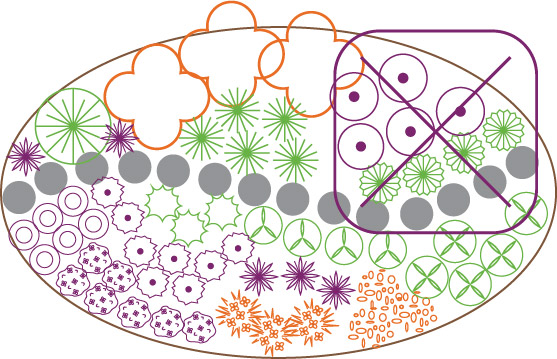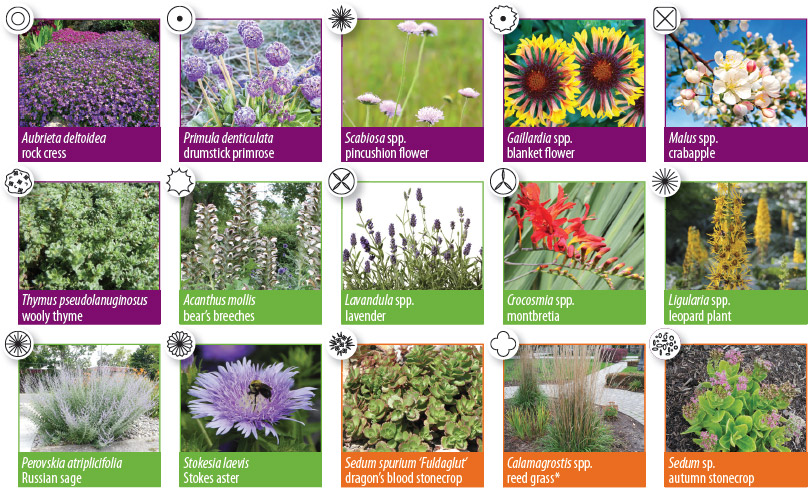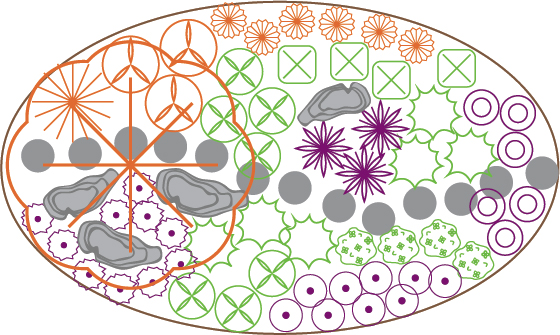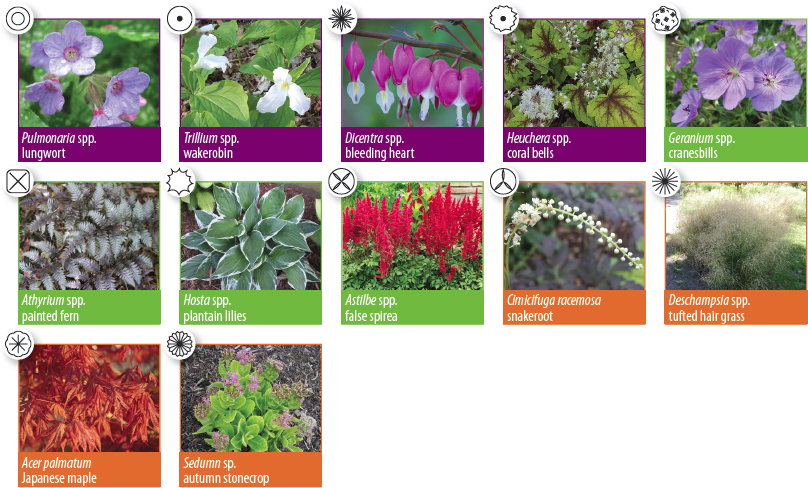On this page
Putting the right plant in the right growing conditions is less work for you, and uses less water.
Consider sun, soil and drainage before choosing plants for your garden. Once a month, watch the movement of the sun and shadows in your yard to know where you have sun and shade.
For the first few weeks, keep the top 2.5 centimetres (1 inch) of soil moist. After that, water once a week until plants are established (one to two seasons). Then your plants should thrive on regular rainfall.
Add 5 to10 centimetres (2 to 4 inches) of mulch every two to four years to help reduce watering needs throughout the summer.
Add 5 centimetres (2 inches) of organic material (e.g. compost, manure, leaf mold) to the soil every couple of years. This provides a constant supply of nutrients, so you don’t need fertilizer the need to fertilize.
Decorative garden design—full sun
At least six hours of direct sunlight a day


Plants used in this design
Spring interest
- Aubrieta deltoidea, rock cress
- Gaillardia species, blanket flower
- Malus spp., crabapple
- Primula denticulata, drumstick primrose
- Scabiosa species, pincushion flower
- Thymus pseudolanuginosus, wooly thyme
Summer interest
- Acanthus mollis, bear’s breeches
- Crocosmia species, montbretia
- Lavandula species, lavender
- Ligularia species, leopard plant
- Perovskia atriplicifolia, Russian sage
- Stokesia laevis, Stokes aster
Fall interest
- Calamagrostis species, reed grass (can be invasive)
- Sedum species, autumn stonecrop
- Sedum spurium ‘Fuldaglut’, dragon’s blood stonecrop
Printer-friendly: Sun-ornamental-garden
Decorative garden design—part sun
Three to six hours of sun a day


Decorative plants part sun
Spring interest
- Acanthus mollis, bear’s breeches
- Helleborus spp., lenten rose
- Symphoricarpos spp., snowberry
- Tiarella cordifolia, foam flower
Summer interest
- Chelone glabra, white turtlehead
- Platycodon grandiflorus, balloon flower
- Pulsatilla spp., pasque flower
- Scabiosa spp., pincushion flower
- Sisyrinchium spp., blue-eyed grass
- Thalictrum spp., meadow rue
Fall interest
- Carex oshimensis, ‘Evergold’ variegated Japanese sedge
- Cimicifuga racemosa, snakeroot
- Deschampsia spp., tufted hair grass
- Epimedium spp., barrenwort
- Symphyotrichum laeve, smooth aster
Printer-friendly: Part sun – ornamental garden
Decorative garden design—shade
Full–shade plants; less than three hours of sunlight; preferably not intense afternoon sun.
Part-shade plants; three to six hours of indirect sun.
The secret to a successful shade garden is to keep adding organic material so the soil doesn’t dry out.
To create soil that mimics the conditions of a forest floor (rich, moist soil). Add at least 5 centimetres (2 inches) of organic material (e.g. manure, compost, leaf mold) every few years and rake leaves into the garden in the fall.
Some shade plants can spread quickly. Thin these plants regularly to prevent them from taking over your garden.


Decorative plants shade
Spring interest
- Dicentra species, bleeding heart
- Heuchera species, coral bells
- Pulmonaria species, lungwort
- Trillium species, wakerobin
Summer interest
- Astilbe species, false spirea
- Athyrium species, painted fern
- Geranium species, cranesbills
- Hosta species, plantain lilies
Fall interest
- Acer palmatum, Japanese maple
- Cimicifuga racemosa, snakeroot
- Deschampsia species, tufted hair grass
- Sedumn species, autumn stonecrop
